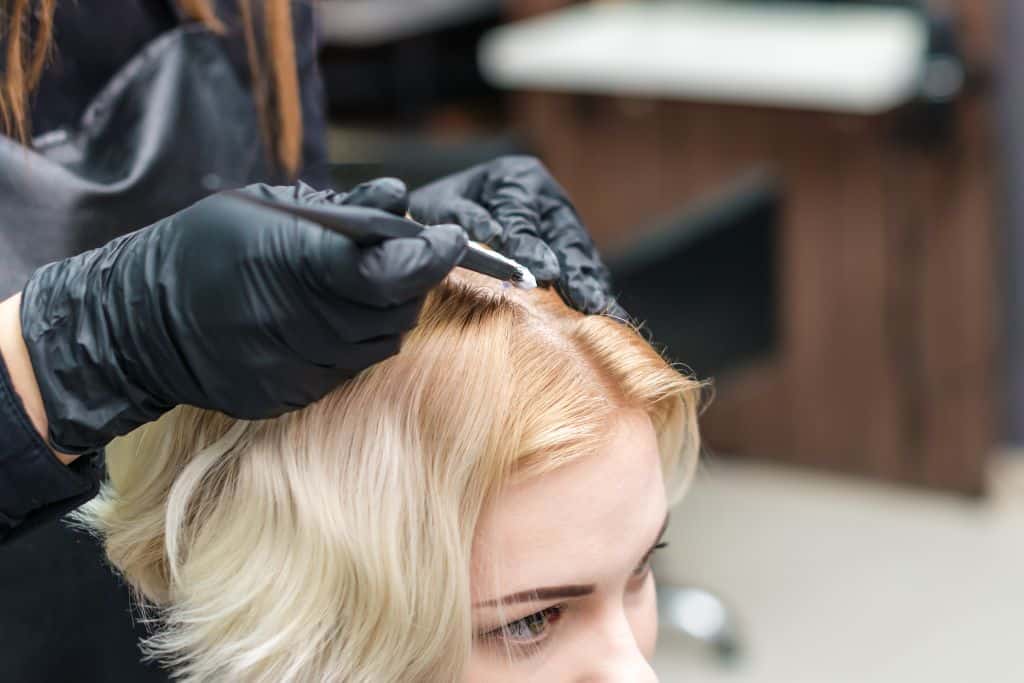Last Updated on December 17, 2022 by Evelyn Davies
Written by Evelyn DaviesHot roots, what are they? How to avoid hot roots and a hair color guide directly written by a hairdresser. Maybe you need a little color correction advice or just need a slight formula tweak.
So, the term hot roots is an easy way to describe a color that has not quite gone the way you or your stylist was planning. I also refer to hot roots as root glow. It basically means the root of the hair is warmer, lighter, or brighter than the rest of your color, and it can happen for a number of reasons.
Hot Roots when Bleaching Hair
So, if you have bleached your hair with a lightener and your hair was previously natural, you can end up with a brighter cleaner blonde on the root and not throughout the mid-ends. Hot roots on a super light blonde may look like your mid-lengths are golden/warm, but it could be down to timing.

Why Did the Hot Roots Happen?
When lightening hair, heat speeds up the process, giving a stronger/lighter/brighter effect. So, if you apply a lightener to the scalp first before ends, you can end up with a “hot roots” effect. This is an example on virgin hair, un-chemically processed. The heat from the scalp will accelerate the lightening process, leaving you with uneven brighter blonde hot roots.
If the hot roots are bright and the ends appear warmer, the issue was – the application would have given a more consistent result if the lightener was applied around 1″ away from the scalp, focusing on the areas where it takes longer to lift bright. Then going back in on the root to lift the areas later. Reapplying bleaches on the mid-lengths and ends is not an advisable thing to do, so if you can avoid hot roots when lightening your hair, please try to.
Hot Roots on Colored Dark Hair
So, this example is when you colored your hair dark in the past, and originally it was great, but now you get hot roots and don’t know why. This can be one of two things.
1 – Permanent dark color reapplied over permanent dark color until it has built up over time in the ends, giving the desired lighter look on the roots but making them look like hot roots.
2 – trying to go a lighter shade over dark permanent hair color.
Scenario number 1 is maybe more for the home hair dye readers. Reapplication of dark over dark can create a dark build-up in the ends. Sometimes almost looking black. Making the roots stand out and hot. Coloring hair permanently dark adds tone to the hair, so if you continue over the same strands the color becomes dense. However, the roots have no previous color, so they can go the desired color, or glow brighter depending on the natural color.
Scenario 2 is going to require more knowledge than putting a lighter shade over a dark one. I wish coloring hair was that easy but it is not. You need a clean canvas to go lighter, so you will need to remove permanent color before going lighter, otherwise, you will just continue to get hot roots.
Roots Look Hot but Just Warmer
So maybe this situation isn’t a level of darkness issue and is more tonal. You have possibly decided to change your color to something warmer, but the color history in the rest of the hair dulled the effect, and the clean roots glowed and became hot roots.
How to fix the hot roots? For this example, it’s a little easier, you’re not looking to lift or darken the hair, but to just neutralize the hot roots. You could add what we hairdressers call a base tone, or natural tone to take the edge off the glowing roots.
How to Avoid Hot Roots Altogether
Well, if you’re not going for a color change and you know the possibility of hot roots can be an issue for you, I recommend balancing the color. By this what I mean is using a demi/semi-permanent on the mid-ends, and only permanent at the root. This way you avoid build-up and then avoid hot roots, so long as you stick to the same/similar shades.
My Advice for Your Hot Roots Research
Go to the salon. Speak to a colorist. This stuff isn’t as easy as putting paint on the hair and it magically changes, this is a study we have done for years. Researching the color wheel, and learning about chemicals, the structure of hair, and the laws of color, it isn’t easy for a stylist to correct, let alone somebody with no study in this field. This guide is to give you answers, not to encourage you to home color.
Our writer Evelyn Davies is a traveling hairdresser with lots of hairdressing experience from all over the world. She also writes informative hair care blogs and has extensive knowledge of the industry. Evelyn has experience working as an artistic educator in the UK along with media hairdressing and writing for magazines. She has also owned her own salon for 4 years. On top of that, she now works freelance hairdressing in Amsterdam. Interested in business, the environmental impact of hairdressing, hair-related media, and all things hair. She also loves the outdoors, surfing, hiking, travel, and well-being.

